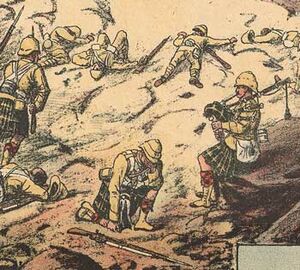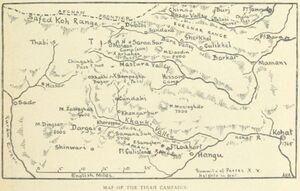حملة تيراه
| Tirah campaign | |||||||
|---|---|---|---|---|---|---|---|
 Though wounded, Sergeant George Findlater continues to play the pipes while the Highlanders storm Dargai Heights. | |||||||
| |||||||
| المتحاربون | |||||||
|
| |||||||
| القادة والزعماء | |||||||
|
|
| ||||||
| القوى | |||||||
|
34,882[1] 20,000 camp followers | 40,000-50,000[1] | ||||||
| الضحايا والخسائر | |||||||
|
1,150 British casualties[2] | Unknown casualties [3] | ||||||
The Tirah campaign, often referred to in contemporary British accounts as the Tirah expedition, was an Indian frontier campaign from September 1897 to April 1898. Tirah is a mountainous tract of country in what was formerly known as Federally Administered Tribal Areas of Pakistan, now Khyber Pakhtunkhwa province.
Rebellion
The Afridi tribe had received a subsidy from the government of British India for the safeguarding of the Khyber Pass for sixteen years; in addition to which the government had maintained for this purpose a local regiment entirely composed of Afridi, who were stationed in the pass. Suddenly, however, the tribesmen rose, captured all the posts in the Khyber held by their own countrymen, and attacked the forts on the Samana Range near the city of Peshawar. The Battle of Saragarhi occurred at this stage when tribesmen led by Orakzai Chief Gul Badshah attacked a British fort. It was estimated that the Afridi and Orakzai could, if united, bring from 40,000 to 50,000 men into the field. The preparations for the expedition occupied some time, and meanwhile British authorities first dealt with the Mohmand rising northwest of the Khyber Pass.[4][5][6]
British advance
October
The general commanding was General Sir William Lockhart commanding the Punjab Army Corps; he had under him 34,882 men, British and Indian, in addition to 20,000 followers. The frontier post of Kohat was selected as the base of the campaign, and it was decided to advance along a single line. On 18 October, the operations commenced, fighting ensuing immediately. The Dargai heights, which commanded the line of advance, were captured without difficulty, but abandoned owing to the want of water. On 20 October the same positions were stormed, with a loss of 199 of the British force killed and wounded. The progress of the expedition, along a difficult track through the mountains, was obstinately contested on 29 October at the Sampagha Pass leading to the Mastura valley, and on 31 October at the Arhanga Pass from the Mastura to the Tirah valley.[1]
November
The force, in detached brigades, now traversed the Tirah district in all directions, and destroyed the walled and fortified hamlets of the Afridi. The two divisions available for this duty numbered about 20,000 men. A force about 3,200 strong commanded by Brigadier-General (afterwards Major General Sir Richard) Westmacott was first employed to attack Saran Sar, which was easily carried, but during the retirement the troops were hard pressed and had 64 casualties. On 11 November, Saran Sar was again attacked by the brigade of Brigadier-General (afterwards Sir Alfred) Gaselee. Experience enabled better dispositions to be made, and the casualties were only three.[1]
The traversing of the valley continued, and on 13 November a third brigade under Brigadier General Francis James Kempster visited the Waran valley via the Tseri Kandao Pass.[1][7][8] Little difficulty was experienced during the advance, and several villages were destroyed; but on 16 November, during the return march, the rearguard was hotly engaged all day, and had to be relieved by fresh troops next morning. British casualties numbered 72. Almost daily the Afridi, too wise to risk general engagements, waged continual guerrilla warfare, and troops engaged in foraging or survey duties were constantly attacked. On 21 November, a brigade under Brigadier-General Westmacott was detached to visit the Rajgul valley. The road was exceedingly difficult and steady opposition was encountered. The objectives were accomplished, but with 23 casualties during the retirement alone. The last task undertaken was the punishment of the Chamkannis, Mamuzais, and Massozais. This was carried out by Brigadier-General Gaselee, who joined hands with the Kurram movable column ordered up for the purpose. On the 29th of November a few shots were fired into headquarters camp injuring two escorts of Sir William Lockhart, including Pratap Singh of Idar, a Rajput Nobleman and orderly officer in the Army Staff. The Mamuzais and Massozais submitted immediately, but the Chamkannis offered resistance on 1 and 2 December, with about 30 British casualties.[1][9]
December
The Kurram column then returned to its camp, and Lockhart prepared to evacuate Tirah, despatching his two divisions by separate routes: the first under Major-General W. Penn Symons (died 1899) to return via the Mastura valley, destroying the forts on the way, and to join at Bara, within easy march of Peshawar; the second division under Major General Yeatman Biggs (died 1898), and, accompanied by Lockhart, to move along the Bara valley. The base was thus to be transferred from Kohat to Peshawar. The return march began on 9 December. The cold was intense, 21 degrees of frost[مطلوب توضيح] being registered before leaving Tirah. The movement of the first division though arduous was practically unopposed, but the 40 miles to be covered by the second division were contested almost throughout.[1]
The march down the Bara valley (34 miles) commenced on 10 December, and involved four days of the hardest fighting and marching of the campaign. The road crossed and recrossed the icy stream, while snow, sleet and rain fell constantly. On the 10th, the casualties numbered about twenty. On the 11th, some fifty or sixty casualties were recorded among the troops, but many followers were killed or died of exposure, and quantities of stores were lost. On the 12th, the column halted for rest. On the 13th, the march was resumed in improved weather, though the cold was still severe. The rearguard was heavily engaged, and the casualties numbered about sixty. On the 14th, after further fighting, a junction with the Peshawar column was effected. The first division, aided by the Peshawar column, now took possession of the Khyber forts without opposition.[1]
Surrender
Negotiations for peace were then begun with the Afridis, who under the threat of another expedition into Tirah in the spring at length agreed to pay the fines and to surrender the rifles demanded. The expeditionary force was broken up on 4 April 1898. A memorable feature of this campaign was the presence in the fighting line of the Imperial Service native troops under their own officers, while several of the best known of the Indian princes served on Lockhart's staff.[1]
See also
Notes
- ^ أ ب ت ث ج ح خ د ذ Blunt 1911, p. 1006.
- ^
- Miller, Stephen M. (2021). Queen Victoria's Wars: British Military Campaigns, 1857–1902. Cambridge University Press. ISBN 978-1-108-49012-2.
- Hutchinson, H. D. (2008). The Campaign in Tirah 1897–1898. Lancer Publishers. ISBN 978-0-9815378-5-6.
- ^ "Archived copy". Khyber. Archived from the original on 22 August 2021. Retrieved 19 April 2022.
{{cite web}}: CS1 maint: archived copy as title (link) CS1 maint: unfit URL (link) - ^ Blunt 1911, pp. 1005–1006.
- ^ The Shillong Times (2017) Forgotten Battle of Saragarhi
- ^ Lionel James, Reuters (1898) The Indian Frontier War
- ^ Biggins 2012.
- ^ "Kempster, Francis James (1855–1925), local Major-General commanding Third Brigade, retired 1902 as Colonel" (Churchill & Gilbert 1967, p. 180)
- ^ COLONEL H. D. HUTCHINSON, Director of Military Education in India (1898) The Tirah Campaign of 1897
References
- Biggins, David (November 2012). "Leinster Regiment (Prince of Wales's): Kempster, Francis James (born 12 March 1855)". AngloBoerWar.com. cites: DSO recipients (VC and DSO Book).
- Churchill, Randolph Spencer; Gilbert, Martin (1967). Winston S. Churchill: Youth, 1874–1900, Part 2 (1876–1900). Vol. 1. Houghton Mifflin. p. 860.
Attribution:
- This article incorporates text from a publication now in the public domain: Blunt, Charles Jasper (1911). . In Chisholm, Hugh (ed.). دائرة المعارف البريطانية. Vol. 26 (eleventh ed.). Cambridge University Press. pp. 1005–1006.
{{cite encyclopedia}}: Cite has empty unknown parameter:|coauthors=(help)
Further reading
- Hernon, Ian (2003). Britain's Forgotten Wars, Colonial Campaigns of the 19th Century. Sutton Publishing. ISBN 978-0-7509-3162-5. (Chapter 18)
- Hutchinson, Col. H.D. (1898). The Campaign in the Tirah 1897-1898: An Account of the Expedition Against the Orakzais & Afridis under Gen. Sir. William Lockhart. London: Macmillan.
- James, Colonel Lionel (1898). The Indian Frontier War: Being an Account of the Mohamud & Tirah Expeditions 1897. London: Heinemann.
- Johnson, Rob. "The 1897 Revolt and Tirah Valley Operations from the Pashtun Perspective" (PDF). Tribal Analysis Center.
- Shadwell, Leonard Julius (1898). Lockhart's advance through Tirah. London: W. Thacker.
- Callwell, C. E. (1911). Tirah 1897. London: Constable.
- Henty, George A (1904). Through Three Campaigns A Story of Chitral, Tirah and Ashanti. – historical fiction
- CS1 maint: unfit URL
- Short description is different from Wikidata
- جميع الصفحات التي تحتاج تنظيف
- مقالات بالمعرفة تحتاج توضيح from October 2021
- مقالات المعرفة المحتوية على معلومات من دائرة المعارف البريطانية طبعة 1911
- Wikipedia articles incorporating text from the 1911 Encyclopædia Britannica
- Tirah campaign
- Conflicts in 1897
- Conflicts in 1898
- 19th-century guerrilla wars
- Wars involving British India
- Wars involving the United Kingdom
- Military history of Khyber Pakhtunkhwa
- 19th-century military history of the United Kingdom
- 1897 in India
- 1898 in India
